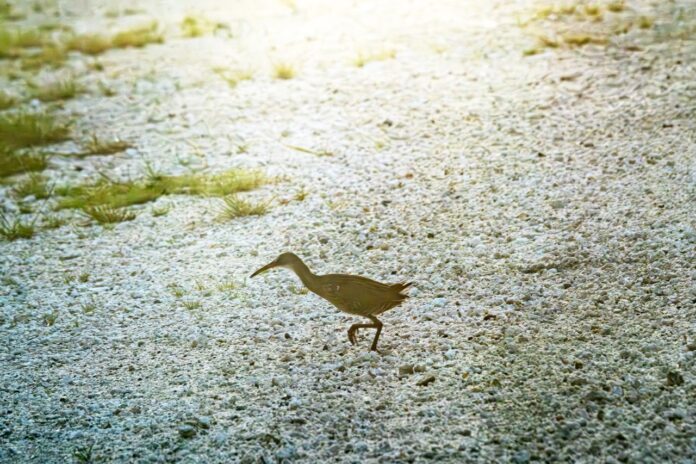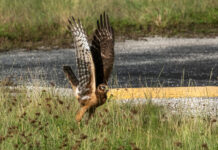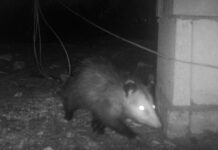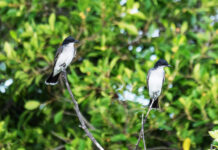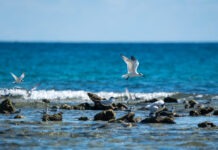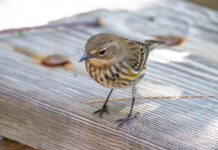I was up on No Name Key the other day, trying to find a reported rarity, when I heard it – the telltale kek.
I had my camera set up and ready to shoot (1/1000, F/5.6, ISO auto). I had the car windows down because a lot of time when you’ve had your camera in the air conditioning and get out into the question-your-life-choices level of Florida humidity, your lens fogs. And with the windows down I heard the kek really well.
Kek is the agreed-upon way to spell out the noise that a clapper rail makes while hiding in the mangroves or, outside of the Keys, in the reeds or grasses of a coastal marsh. It is only occasionally a single syllable. Most times it’s a fistful of keks, 15 or 20, in a rapid rising, then falling, parabola of keks. (I’m going to save some space here and not spell that out.) Sometimes, to add a little nuance, they will call out something known as kek-hurrah, which is thought to be an abbreviation of the many-kekked parabola. Sometimes the females will give out what is known as a kek-burr, thought to be the female’s version of “Hey, sailor.” But kek is their basic unit of sound.
It is not a conventionally pretty sound. At first I wanted to describe it as if a steel wool pad had mated with a strand of barbed wire and somehow learned to sing. But I think it would be more apt to describe it as if someone had somehow combined the laughs of Ernie, of Ernie and Bert fame, and Shane McGowan, of the Pogues fame, with the voices of Donald Duck and Tom Waits, then installed it in a bird that could only survive on espresso and Red Bull.
Not pretty, but damn, my heart fills with joy every time I hear it.
The best times are when I’m looking for something else and one just pipes up unseen out of the mangroves. It’s like the clouds parting, or a bartender telling you the drink is on the house. Sometimes I stop at a place that looks particularly clapper rail-y and listen for them, and when I don’t hear them, try and game the system and play their call loudly on my phone. Sometimes I get a response, but mostly I don’t.
Rails are some of the stealthiest birds out there, and clappers do their family proud. The introduction to their species account in the Cornell Lab of Ornithology’s “Birds of the World” website notes, “Although it is widely distributed and often locally abundant, little is known about many aspects of its biology because the clapper rail is difficult to observe in its dense marsh habitats.”
Their range is essentially the Gulf Coast, the Atlantic Coast up to southern Maine, and the Caribbean. Florida actually has its own subspecies, Rallus crepitans scottii.
Big-bodied, longish-legged, medium-necked, small-headed, longish-billed, not much taller than a pair of size 13 Air Jordans. Their feathers are a melange of grays, browns and oranges, with the occasional bit of white scalloping in the belly. At first they kind of look like something a kid would draw if you just told them to draw a bird without using any of the good crayons.
Birders will often tell you the phrase “thin as a rail” comes from rails, which doesn’t make sense when you look at them in profile, as they look a little plump. The story makes more sense when you see one head on, because many rail species, clapper rails among them, are what is called laterally compressed, meaning skinny from side to side, as if they’d spent a little time clamped in a book vise. But etymologists have thrown cold water on that idea, showing evidence that the phrase refers to fence rails, not birds that are called rails. It’s just a strange bit of linguistic convergent evolution. (Fun fact: Mark Twain was the first person to use the phrase “thin as a rail” in print.)
All of these physical characteristics, of course, contribute to their furtiveness, making it harder for you to see them as they slink around behind the veil of green and brown vegetation that comprises their world. I think this is what I like most about clapper rails. I like that they have these largely secret lives. I like that they soft-step around marshes and swamps and mangroves like cartoon burglars. (I wish they were one of those species that had a burglar-like mask across their eyes, but alas and alack, they are not.)
I realize I’m making it sound as if you never see clapper rails, which is not quite the case. If you do hear them, you have a chance. It’s best if you can muster up a little self-discipline and not make any sudden movements. If there’s an open, muddy area in the mangroves or marsh, either wet or dry, even something as small as 3 or 4 feet across, keep a watchful eye on that. Sometimes they will work along the edge, or sometimes even right through the middle, of the open space. But also pay attention to the areas around it. Sometimes there will be a very subtle shadow moving through the roots, and if you focus your binoculars correctly, you can actually follow them for a good number of seconds. Also pay attention to your peripheral vision.
When I heard the clapper rail on No Name the other day, I stopped the car pretty quickly, then backed up a bit, turned the car off, got out and closed the door as softly as I could, camera slung over my shoulder. I hadn’t heard just one kek, I’d heard an armada of them. And in stereo. There were clapper rails on both sides of the road, throwing fusillades of keks at each other. It sounded angry, though most likely it was just them checking in with each other, and this time of year, maybe keeping track of their offspring.
I did what I advised above. Found an open spot and focused on that. Told myself I am a patient person and that if I just don’t move too quickly, I might see one. Which was when I caught sight of a clapper rail off to my left, fast walking warily across the road.
I turned and lifted my camera (pretty smoothly I must say) – he’d already seen that I was there, so he didn’t really spook. I managed to shoot a couple frames before he disappeared into the mangroves in front of me. And when I was shooting I realized my lens was still fogged, despite driving with the windows down.
It actually turned out to be a pretty lousy photo. But I think it shows you a little more of the clapper rail’s character than a good one might.










